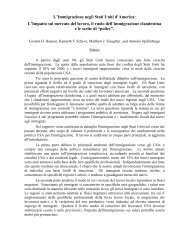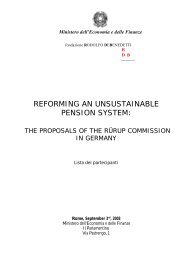The Executive Compensation Controversy - Fondazione Rodolfo ...
The Executive Compensation Controversy - Fondazione Rodolfo ...
The Executive Compensation Controversy - Fondazione Rodolfo ...
You also want an ePaper? Increase the reach of your titles
YUMPU automatically turns print PDFs into web optimized ePapers that Google loves.
THE EXECUTIVE COMPENSATION CONTROVERSY: 24 MAY 2010A TRANSATLANTIC ANALYSIScomposition of publicly listed firms, and includes detailed biographic information onindividual executives and board members in nearly 50 countries (including countries that donot have mandatory disclosure requirements for executive compensation). 82 We restrict ouranalysis to the individual identified by BoardEx as the highest-ranking executive in eachfirm, and use the term “CEO” to describe this executive, regardless of whether the firm uses“chief executive officer” or some other designation (such as “managing director” or“executive chairman”). In addition to providing biographic information, BoardEx alsoincludes detailed compensation data for top executives – including salaries, other pay,bonuses, payouts under long-term plans, option grants, and share grants.We focus on the nine countries in Table 3.1 that had codes or laws requiring thedisclosure of cash and share-based compensation for individual executives: Belgium, France,Germany, Ireland, Italy, Netherlands, Spain, Sweden, and the UK. In addition, we includeSwitzerland, which while not a member of the European Union nonetheless adopted EU-styledisclosure rules. 83 In the case of Switzerland, individual compensation is reported only forthe “highest-paid” executive who might not be the CEO. For our USA comparisons, we relyon Standard and Poor’s ExecuComp database, as we did in Section 2. However, while werestricted our analysis in Section 2 to the S&P 500 (essentially the 500 largest firms rankedby market capitalization), we now employ the entire ExecuComp database, which alsoincludes firms in the S&P MidCap 400, and S&P SmallCap 600, additional firms thatExecuComp continues to follow even after dropping out of one of their major indices.Finally, we restrict our analysis to companies with annual revenues in excess of €100 millionto reduce the impact of BoardEx’s over-sampling of small UK firms.Two aspects of BoardEx’s compensation calculation deserve special mention. First,instead of providing grant-date values for stock option grants (as in ExecuComp for our USAfirms), BoardEx computes the value of options granted using the closing stock price on thelast trading day of the fiscal year rather than the stock price on the grant date. Since worldstock prices declined at the end of 2008, valuing options using fiscal year-end stock prices (ala BoardEx) produces a slightly lower value than using grant-date prices (a la ExecuComp).Second, for performance share plans (in which the number of restricted shares awarded isbased on realized performance), BoardEx computes the value based on the maximum (rather82 <strong>The</strong> BoardEx data are used in Cohen, et al. (2008) to study links between CEOs and mutual fund managersin the U.S. and in Ferreira and Matos (2008) to study board links between banks and firms worldwide.83 Under Switzerland regulations, companies must disclosure the pay for the “highest-paid executive” whomight not be the CEO; our compensation data for Switzerland therefore potentially upward biased.-62-









